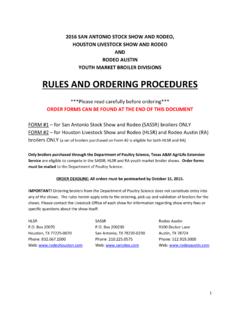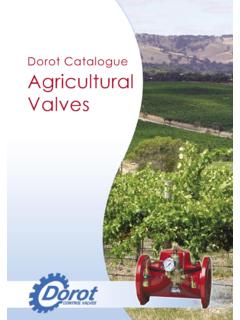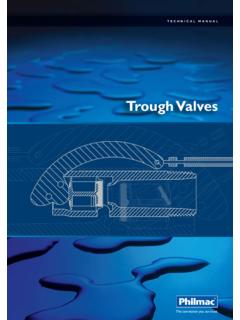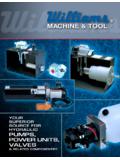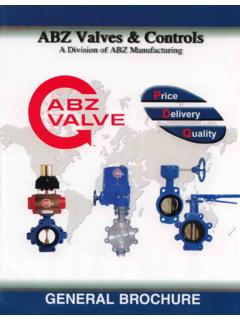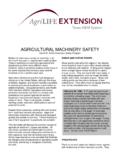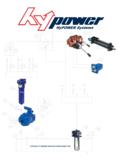Transcription of Calculating Horsepower Requirements and Sizing Irrigation ...
1 Pumping costs are often one of the largest singleexpenses in irrigated agriculture. Table 1 shows typicalfuel use and costs of pumping in Texas as measured inirrigation pumping plant tests conducted by the TexasAgricultural Extension Service. Properly Sizing pipe-lines for the particular situation will help minimizethese costs. This publication outlines how to calculatethe Horsepower Requirements of Irrigation pumps andhow to use this information in Sizing supply Plant EfficiencyAn Irrigation pumping plant has three major compo-nents: 1. a power unit, 2. a pump drive or gear head, and3.
2 A pump. For electric powered plants, the pump lineshaft andthe motor shaft are usually directly connected, makinga pump drive or gear head overall pumping plant efficiencyis a combination ofthe efficiencies of each separate component. Individualpumping unit components in good condition and care-fully matched to the Requirements of a specific pump-ing situation can have efficiencies similar to those givenin Table 2. However, many pumping units operate atefficiencies far below acceptable levels (Table 3).Additional details on pumping plant efficiency aregiven in L-2218, Pumping Plant Efficiency and IrrigationCosts, (available from your county Extension agent).
3 Performance StandardsThere are two commom methods of determining theefficiency of pumping plants. One is to measure the effi-ciency of each component of the plant (motor, shaft andpump). Once the efficiencies of the components areknown, the overall efficiency is easily calculated. Thisrequires specialized equipment and considerable method is to calculate the load on the motoror engine and then measure how much fuel is used bythe power unit. The fuel usage can then be compared toa standard. The most widely used standards weredeveloped by the Agricultural Engineering Departmentof the University of Nebraska (Table 4).
4 The fuel con-sumption rates in Table 4 indicate the fuel use whichcan be reasonably expectedfrom a properly engineeredirrigation pumping plant in good condition. The actualfuel usage of a new or reconditioned plant should notbe larger than that shown in Table HorsepowerHorsepower is a measurement of the amount ofenergy necessary to do work. In determining the horse-power used to pump water, we must know the:1. pumping rate in gallons per minute (gpm), and 2. total dynamic head (TDH) in feet. The theoretical power needed for pumping water iscalled water Horsepower (whp) and is calculated by:(equation 1)whp =gpm x TDH (ft)3,960 Since no device or machine is 100 percent efficient,the Horsepower output of the power unit must be high-er than that calculated with equation 1.
5 This horsepow-er, referred to as brake Horsepower (bhp), is calculatedby:(equation 2)bhp =whp(pumping plant efficiency)Total Dynamic Head (TDH)TDH may be viewed as the total load on the pump-ing plant. This load is usually expressed in feet of head (1 psi, or pound per square inch = feet ofCalculating Horsepower Requirementsand Sizing Irrigation Supply PipelinesGuy Fipps**Extension agricultural engineer, The Texas A&M University Agricultural Extension Service Zerle L. Carpenter, Director The Texas A&M University System College Station, TexasB-6011head). TDH can be calculated with the following equa-tion:(equation 3) TDH = (static head) + (friction loss) + (operating pressure) + (elevation change)Pumping lift: Pumping lift is the vertical distancefrom the water level in the well to the pump outlet dur-ing pumping.
6 In areas of falling water table, often themaximum depth to the water table expected during thepumping season is loss: Water flowing past the rough walls in apipe creates friction which causes a loss in losses also occur when water flows throughpipe fittings, or when the pipe suddenly increases ordecreases in diameter. Tables with values for frictionloss through pipe and fittings similar to Tables 6 and 7are widely available. Operating pressure Requirements : Manufacturersprovide recommended operating pressures for specificwater applicators in Irrigation systems. Operating pres-sure in psiis converted to feet of headby the relationship:1 psi = change: Use the total change in elevationfrom the pump to the point of discharge, such as theend of the pipeline or sprinkler head.
7 This elevationchange may be positive (when the Irrigation system isuphill from the pump) or negative (when it is downhillfrom the pump). Use only the difference in elevationbetween these two points, not the sum of each uphill ordownhill section. Do not forget to add the distancefrom the ground to the point of water discharge, partic-ularly for center pivot center pivots, elevation differences caused byslopes in the field usually are accounted for in the com-puter printout of the design, and are included in theoperating pressure Requirements . If not, then the eleva-tion change from the pivot point to the highest point inthe field should be added to the total elevation Irrigation MainlinesIn Sizing Irrigation water supply pipelines, two fac-tors are important: friction lossesand water hammer; bothare influenced by the relationship between flow rate (orvelocity) and pipe size.
8 Water HammerWhen moving water is subjected to a sudden changein flow, shock waves are produced. This is referred to aswater hammer or surge pressure. Water hammer may becaused by shock waves created by sudden increases ordecreases in the velocity of the water. Flow changes andshock waves can occur when valves are opened, pumpsare started or stopped, or water encounters directionalchanges caused by pipe fittings. Controlling Water HammerTo control surge pressure in situations where exces-sive pressures can develop by operating the pump withall valves closed, pressure relief valves are installedbetween the pump discharge and the pipeline.
9 Also,pressure relief valves or surge chambers should beinstalled on the discharge side of the check valve whereback flow may occur. Air trapped in a pipeline can con-tribute to water hammer. Air can compress and expandin the pipeline, causing velocity changes. To minimizesuch problems, prevent air from accumulating in thesystem by installing air-relief valves at the high pointsof the pipeline, at the end, and at the entrance. Other general recommendations for minimizingwater hammer include:1. For long pipelines sloping up from the pump,install nonslam check valves designed to closeat zero velocity and before the column of waterabove the pump has an opportunity to move In filling a long piping system, the flow should becontrolled with a gate valve to approximatelythree-fourths of the operating capacity.
10 When thelines have filled, the valve should then be slowlyopened until full operating capacity and pressureare Feet per Second RuleTo minimize water hammer, especially for plastic(PVC) pipe, water velocities should be limited to 5 ft/s(feet per second) unless special considerations are givento controlling water hammer. Most experts agree thatthe velocity should never exceed 10 ft/s. Also, thevelocity of flow in the suction pipe of centrifugalpumps should be kept between 2 and 3 ft/s in order toprevent cavitation. Table 5 lists the maximum flow ratesrecommended for different ID (internal diameter) pipesizes using the 5 ft/s rule.
